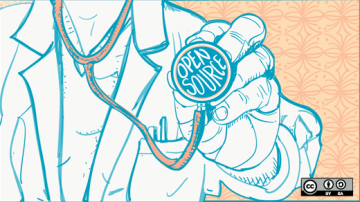Managers of open source communities have to be aware of the 5 levels of transparency that they can provide. These 5 levels of transparency are important for building a thriving open source community.
This article describes each level, its goals, and why they are important. But first, I revisit why transparency is important for open source ecosystems.
Why do open source ecosystems need transparency?
- Transparent communities inspire trust in each other, which greases the wheels of collaboration.
- Communities work together and exchange messages in the open.
- Open source work happens in a transparent way to avoid friction.
- Community managers need to report to their stakeholders.
- Showing communities what information is available about them is healthy and encourages trust.
What are the 5 levels of transparency?
Transparency level 1: Publish source code
This level is about releasing source code under an Open Source Initiative (OSI)-approved license in a public-facing version control system like Git.
The first level's goal is to establish an open source project.
- This level is self-evident as there would be no open source project without the source code.
- At the core of an open source project is the source code that people engage with—licensed under an OSI-approved license.
- A public version control system enables collaboration and allows everyone to analyze the project and understand the collaboration patterns.
Transparency level 2: Publish community guidelines
You publish documentation and resources on contributing at this level, and you organize special events to educate the community.
The second level's goal is to create and grow a community for an open source project.
- Building an active community requires more than just having a source code.
- Being transparent about how a project works and how to contribute enables others to join a project.
- Growing the community may involve running events and doing special activities for contributors.
Transparency level 3: Celebrate successes
Once you reach this level, it's important to share insights about the community and publish reports about the project's status.
The third level's goal is to celebrate successes and secure further support beyond the initial phase of the community.
- As open source communities grow, it becomes harder to know what's happening everywhere.
- Being transparent about the activities in the community helps community members know that their contributions are being seen and valued.
- At this level of transparency, the reporting and analytics are sporadic and without specific tooling.
Transparency level 4: Understand the pulse of the community
This level is all about listening to the community—keeping an eye on the project's evolution in community activity and the software development process to take corrective actions.
The fourth level's goal is to take the community to the next level by understanding its evolution and trajectory with consistency and scientific rigor.
- Reporting mechanisms and analytics tools help keep an eye on what is happening.
- You can compare events in the community and the subsequent reactions of community members to a baseline and other events in the community.
- Deeper insights into the community are possible with consistent listening.
Transparency level 5: Maintain the community long-term
The last step is acting on community metrics and improving community engagement.
The fifth level's goal is to make meaningful and impactful decisions about community engagement.
- Have systems in place to react to changes in community metrics.
- Follow up on how changes to the community are showing up in the metrics and analytics about the community.
- Set "SLAs" and accountability for maintainers or developers to have goals for their community engagement and at a system level makes sure things get done.
Wrap up
Open source community managers need to apply these 5 levels of transparency to build a thriving open source community.











Comments are closed.